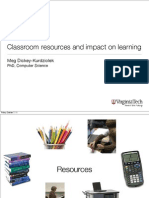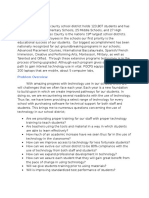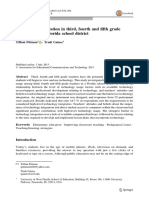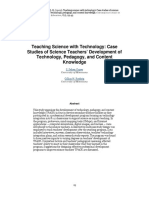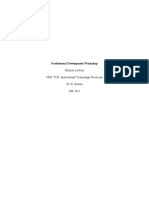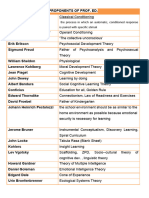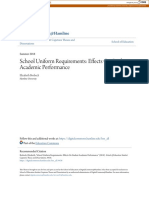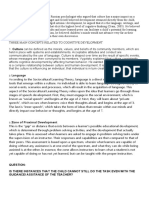PICRAT
The PICRAT Technology Integration Model
Royce Kimmons, Darren Edgar Draper, & Joe Backman
DOI:10.59668/371.5895
Technology Integration PICRAT Teacher Education Technology Integration Model Transformation
PICRAT is a technology integration model for teacher education intended to assist teachers in improving their
classroom practices. PICRAT (Kimmons et al., 2020; see Figure 1) has two parts representing two guiding
questions: PIC and RAT. The PIC part responds to the question “What is the student’s relationship to the
technology” with one of three responses: Passive, Interactive, or Creative. The RAT (Hughes et al., 2006) part
responds to the question “How is the use of technology influencing the teacher’s existing practice” with one of
three responses: Replacement, Amplification, or Transformation. Answers to these two questions are organized
into a 3x3 visual matrix (with PR on the bottom left and CT on the top-right; see Figure 1). Practices are
interpreted hierarchically with more active, more effective, and better-justified classroom technology practices
generally occurring at the top-right of the matrix.
Because technologies are always changing and educational contexts vary so greatly from one another, teacher
educators and professional development providers need tools to train teachers that are simple, flexible, and practical
while guiding educators in self-improvement through reflective practice. PICRAT is a framework to help teachers and
teacher education students to be self-reflective in their technology integration practices and to engage in learning
activities that are more interactive and creative for students while amplifying or transforming their own practices
(Kimmons et al., 2020). The PIC part of the matrix loosely aligns with Bloom’s taxonomy of educational objectives for
the cognitive domain (Bloom et al., 1956; see Figure 2), where passive learning activities might favor lower-level
cognitive objectives like remembering, interactive activities might favor mid-level objectives like applying, and creative
activities might favor higher-level objectives. The RAT part of the matrix suggests that teacher practices with
technologies exhibit differing levels of relative advantage to a teacher’s pedagogy (Hughes et al., 2006), with some
practices being more pedagogically beneficial than others.
225
�Figure 1
The PICRAT Matrix
Figure 2
Alignment of PIC to Bloom’s Taxonomy
226
�The PICRAT matrix can be particularly useful when teachers reflect upon their practice by analyzing existing or
proposed learning activities according to the framework. Intended to assist teachers in ongoing improvement efforts,
teachers using PICRAT consider how their past or potential future practices might make better use of technologies,
thereby improving both student engagement and learning outcomes. Consider, for example, the teacher who might
traditionally lecture from a PowerPoint presentation full of text (Passive Replacement or PR). Improved instructional
experiences like the following could be considered:
Students are provided a copy of the PowerPoint slides to peruse at their own pace and self-direction (I or
Interactive).
The teacher inserts rich media throughout the self-paced PowerPoint lesson, to improve comprehension of difficult
concepts (A).
The teacher uses Nearpod or Peardeck instead of PowerPoint, embedding Drag & Drop, Draw It, or other activities
throughout the lesson, encouraging students to engage with the instructional material (IA).
Students create their own presentation showcasing their knowledge (C).
The entire class uses Lucid Spark to engage in a live, whole-class brainstorming session, allowing teachers and
students to see the thought processes of others as they participate and generate knowledge together (CT).
One key insight of PICRAT is that any technology might be used in a variety of ways, with some practices being more
educationally valuable than others. Consider, for example, the myriad ways that the Nearpod application might be used
by a science teacher (see Table 1). Depending on the educational goal, teachers may elect to work within any cell of the
framework, even when using the same tool. This means that the practices surrounding technology use are better
indicators of educational merit than the technologies themselves (e.g., just because teachers are using Nearpod does
not mean that they are doing things that are particularly valuable for their students or practice).
Table 1
Examples of Nearpod Classroom Activities within a Biology Classroom Revealing Different PICRAT Levels
227
�Creative Teacher assigns each Teacher provides an ethical dilemma Students engage with each other
student a genetic term to regarding genetic modification along and the teacher using a Nearpod
define and has students with online resources for students to collaboration board to collect and
present their terms to the explore in Nearpod small groups; they thematically organize examples of
class via Nearpod. then report their solution to the entire current genetics research.
class.
Interactive Teacher begins the class Teacher embeds Draw It activities Teacher embeds Drag and Drop
session with a Nearpod among Nearpod slides to encourage activities among Nearpod slides to
quiz, covering the previous student participation. assess student understanding,
night’s homework on making instructional adjustments on
cellular structure. the fly.
Passive Teacher shows Nearpod Teacher embeds instructional videos in Teacher uses Nearpod + Zoom
slides detailing cellular Nearpod slides to better explain integration to virtually host a
replication during a whole- difficult concepts. geneticist from a research center to
class lecture. provide a guest lecture.
Replacement Amplification Transformation
The more difficult parts of PICRAT for educators to understand and master in practice often include the Creative and
Transformative levels. To clarify, by “Creative,” PICRAT authors mean knowledge artifact creation, similar to
constructionism (cf., Kafai & Resnick, 1996), rather than artistic creativity. Additionally, whether technology can ever
play a transformative role in education is a contested idea in itself (Clark, 1994; Kozma, 1994), and even if
transformation exists, the line between Amplifying and Transformative practice may seem a bit ill-defined. PICRAT
authors contend that some instances of technology integration in classrooms increase efficiencies or opportunities to
such a degree that it no longer seems reasonable to treat them merely as amplifying or functional improvements,
meaning that they should be treated as Transformative (Kimmons et al., 2020). Furthermore, by leaving the line between
Amplification and Transformation a bit blurry, professionals are empowered to use their best judgment to grapple with
this important issue in their own settings. Rational professionals can disagree on whether a particular instance of
technology use is Amplifying or Transforming practice, but PICRAT authors contend that having such reflective
discussions (either with colleagues or with oneself) is a valuable exercise, as it forces educators to constantly grapple
with the effects technology applications have upon their practice.
In addition, one common concern with PICRAT is that its hierarchical structure might be viewed as delegitimizing some
technology practices that are educationally valuable. For example, if a teacher shows a YouTube video to a class, this
activity might be interpreted as poor practice, because the students are Passive, and the video might just consist of a
talking head, thereby Replacing a lecture (PR). Rather than interpreting this to mean that teachers should never show
YouTube videos to students, PICRAT should be used to consider (a) whether there are additional ways to have students
engage in the learning process beyond watching the video (i.e., Interaction and Creation), (b) whether some videos
might be better than others (i.e., those that provide Amplifying or Transformative learning opportunities), and (c)
whether practices near the bottom-left are being done for their educational merit or due to lack of planning and
reflection. Even the best classrooms using technology will likely exhibit some practices that fall near the bottom-left of
PICRAT, and this is expected. However, if all practices with technology are of this type or if teachers are seeking ways to
use technology to improve pedagogy or to make learning more active and engaged, then practices that would be
classified more toward the top-right of the matrix should also be sought after.
References
Amador, J., Kimmons, R., Miller, B., Desjardins, C. D., Hall, C. (2015). Preparing preservice teachers to become self-
reflective of their technology integration practices. In M. L. Niess & H. Gillow-Wiles (Eds.), Handbook of Research
on Teacher Education in the Digital Age (pp. 81-107). Hershey, PA: IGI Global.
228
�Bloom, B. S., Englehart, M. D., Furst, E. J., Hill, W. H., & Krathwohl, D. R. (1956). Taxonomy of educational objectives.
Handbook 1: Cognitive domain. New York: Longmans, Green.
Clark, R. E. (1994). Media will never influence learning. Educational Technology Research and Development, 42(2), 21-
29.
Hughes, J., Thomas, R., & Scharber, C. (2006). Assessing technology integration: The RAT – Replacement, Amplification,
and Transformation – framework. In Proceedings of SITE 2006: Society for Information Technology & Teacher
Education International Conference (pp. 1616–1620). Chesapeake, VA: Association for the Advancement of
Computing in Education.
Kafai, Y. B., & Resnick, M. (2012). Constructionism in practice: Designing, thinking, and learning in a digital world.
Routledge.
Kimmons, R., Graham, C., & West, R. (2020). The PICRAT model for technology integration in teacher preparation.
Contemporary Issues in Technology and Teacher Education, 20(1).
Kimmons, R., & Hall, C. (2016). Emerging technology integration models. In G. Veletsianos (Ed.), Emergence and
innovation in digital learning: Foundations and applications. Edmonton, AB: Athabasca University Press.
Kimmons, R., & Hall, C. (2017). How useful are our models? Pre-service and practicing teacher evaluations of
technology integration models. TechTrends, 62, 29-36. doi:10.1007/s11528-017-0227-8
Kimmons, R., Miller, B., Amador, J., Desjardins, C., & Hall, C. (2015). Technology integration coursework and finding
meaning in pre-service teachers' reflective practice. Educational Technology Research and Development, 63(6),
809-829. doi:10.1007/s11423-015-9394-5
Kozma, R. B. (1994). Will media influence learning? Reframing the debate. Educational Technology Research and
Development, 42(2), 7-19.
Community Artifacts
Watch on YouTube
229
�Biola, S. (n.d.). PICRAT Flow chart. https://docs.google.com/drawings/d/1W4wuf5O3dAAU_2RBHRT1motXKmm5f35Le-
4PvSAbBMA/edit
Constantine, A., & Jung, K. G. (2019). Using digital science notebooks to support elementary student learning: Lessons
and perspectives from a fifth-grade science classroom. Contemporary Issues in Technology and Teacher
Education, 19(3), 373-412.
Heberer Jr, D. H. (2021). Teacher Perceptions & Practice of Technology Integration before and after PICRAT Matrix
Professional Development Intervention (Doctoral dissertation, St. John's University, New York).
Kimmons, R. (2018). Technology Integration: Effectively Integrating Technology in Educational Settings. In A. Ottenbreit-
Leftwich & R. Kimmons, The K-12 Educational Technology Handbook. EdTech Books. Retrieved from
https://edtechbooks.org/k12handbook/technology_integration
Kimmons, R. (2018). K-12 Technology Frameworks. In R. E. West, Foundations of Learning and Instructional Design
Technology: The Past, Present, and Future of Learning and Instructional Design Technology. EdTech Books.
Retrieved from https://edtechbooks.org/lidtfoundations/k12_tech_frameworks
Il modello PIC RAT (Italian). Testo e realizzazione: Christian Biasco, Centro Risorse Didattiche e Digitali, Cantone Ticino.
https://edutich.sharepoint.com/:v:/s/O365Group_2052/EfQyRey02cxGq-eUE4EFRvoBr3dxIUl51YGgODetN8jn3g?
e=q1v0RP
Royce Kimmons
Brigham Young University
Royce Kimmons is an Associate Professor of Instructional Psychology and
Technology at Brigham Young University where he seeks to end the effects of
socioeconomic divides on educational opportunities through open education and
transformative technology use. He is the founder of EdTechBooks.org,
open.byu.edu, and many other sites focused on providing free, high-quality learning
resources to all. More information about his work may be found at
http://roycekimmons.com, and you may also dialogue with him on Twitter
@roycekimmons.
230
� Darren Edgar Draper
Alpine School District
A fierce and faithful proponent of the effective use of technology in schools, Dr.
Darren E. Draper is a CoSN Certified Education Technology Leader who currently
serves as the Director of Innovative Learning in the Alpine School District. As the
largest school district in the state of Utah, Alpine District educates over 80,000
students.
Darren is a regular presenter at ed-tech and academic conferences nationwide, and
has over twenty five years of experience in the field. Most recently, his professional
interests include academic coaching, personalized and competency-based
education, technology-enabled professional learning in its many forms, and the
academic application of social networking. He's been blogging at
http://drapestak.es and chatting on Twitter for over a decade (@ddraper), and
would love to connect to learn more with you!
Joe Backman
Alpine School District
Dr. Joe Backman, Curriculum Director of Professional Learning and Elementary
Mathematics for Alpine School District (largest in Utah) has led out on professional
learning in all 62 elementary schools in Alpine to ensure students acquire the
essential knowledge, skills, and dispositions they need to thrive in life. Joe has been
an elementary teacher, BYU partnership facilitator and CFA, school principal, and
curriculum director. He has presented nationally and internationally on the work and
research in Alpine. He led his school and district to partner with universities,
businesses, and has helped schools network as multi-school PLCs. He continues to
perform educational research at BYU and has been an adjunct professor. Dr.
Backman received his undergraduate degree in Elementary Education, and a
Master's Degree and Ph.D. in Educational Leadership at BYU. Joe and his wife are
proud parents of four awesome boys and one beautiful baby girl.
This content is provided to you freely by EdTech Books.
Access it online or download it at https://edtechbooks.org/encyclopedia/picrat.
231
�232









